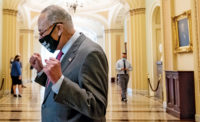Mark Twain's famous reply to a reporter about the rumors that the author was seriously ill and had died, “The reports of my death are greatly exaggerated,” came to mind recently.
I was reminded of it following the aborted May 22 White House infrastructure meeting between President Donald Trump, on one side, and House Speaker Nancy Pelosi and Senate Minority Leader Charles Schumer, on the other.

Just as a newspaper prematurely reported Twain’s death, D.C.-based political pundits and prognosticators are already declaring infrastructure legislation dead this session. Not so fast.
Political theatrics aside, at least three fundamental factors remain unchanged.
Outside the D.C. bubble, more than 30 states have raised revenue to support expanded transportation improvements since 2013.
First, upgrading our roads, bridges and transit system has been a top bipartisan priority since the 2016 elections and one of the few areas of common ground between the House and Senate. Even in divided government, many lawmakers want to demonstrate they can govern to earn re-election in 2020.
Second, there are 235,000 U.S. bridges in need of repair or major rehabilitation. As we reported April 1 with our sixth annual bridge conditions report, the pace of repair has slowed to its lowest point in a half-decade. As overwhelming as this data is, bridges are a symptom of the nation’s unmet and growing transportation infrastructure challenges.
Third, the Highway Trust Fund remains in the financial hurt locker. When the current FAST Act law expires in October 2020, there will be an $18 billion average annual shortfall between incoming trust fund revenues and what’s needed to maintain current federal highway and transit investment levels. Absent congressional action or a new revenue stream, states could face a 40 percent cut in investment starting in 2021.
The heavy lift of writing infrastructure legislation always depended on congressional shoulders. ARTBA has no intention of standing on the sidelines while the legislative process plays out. We are sharing with members of Congress our 32-page legislative blueprint for the next highway and transit bill that was approved by our board in May.
Meanwhile, House leaders are working toward a comprehensive infrastructure package and have scheduled floor time for debate later this summer. The Senate is planning to accelerate its version the highway and transit reauthorization bill in 2019 instead of 2020. The difference in legislative approach isn’t surprising; it simply reflects how each chamber operates.
Outside the D.C. bubble, more than 30 states have raised revenue to support expanded transportation improvements since 2013. It’s time for the federal government to do its part with any final bill that emerges. All funding options, including an increase in the gasoline tax and new freight-related user fees, should be on the table.
While it’s easy to be cynical about Washington’s political gridlock and argue the demise of new infrastructure legislation, recent history offers lessons to the contrary.
Prior Premature Obituaries
On June 21, 2012, a Washington publication widely read by thousands of transportation industry professionals declared, “Hopes for a Compromise for a Highway Bill Are Fading.” A short time later, on July 6, President Obama signed the multi-year MAP-21. Similar obituaries were written before President Obama signed the five-year FAST Act in December 2015.
No one believes the task at hand will be easy. Readers of ENR—the leaders in the transportation design, construction and safety industry—can’t stay on the sidelines, either.
The Highway Trust Fund is the source, on average, or more than 50 percent of annual highway and bridge capital improvements made by state governments annually. Current federal highway and public transit investment stands at about $60 billion. This is a major component of your market and should not be left for others to control.
ARTBA’s call-to-action message is this: Invite members of your congressional delegation to your headquarters or job sites this summer. Let them meet your employees and see the real-world impacts of the decisions they make. Most importantly, tell them to permanently fix the Highway Trust Fund and pass a robust federal infrastructure package this year.
It’s the collective responsibility of everyone in our industry to ensure the future U.S. transportation network is alive and kicking.





Post a comment to this article
Report Abusive Comment